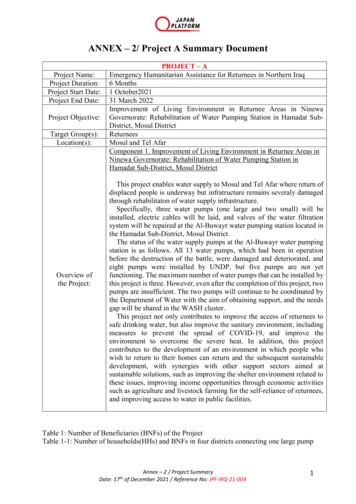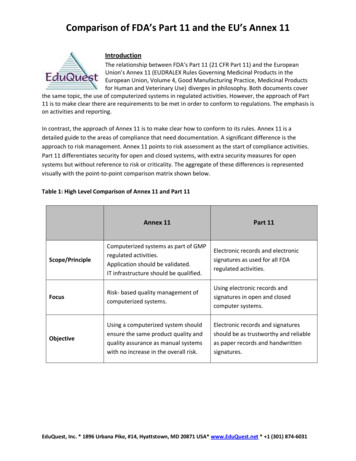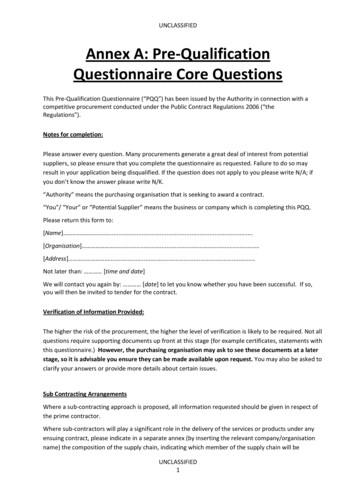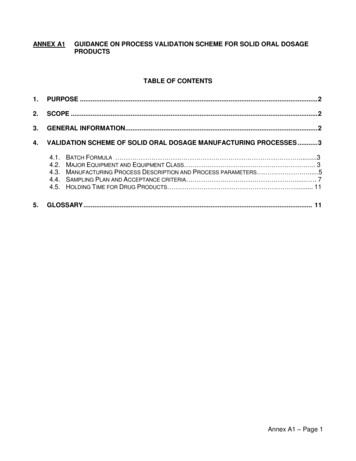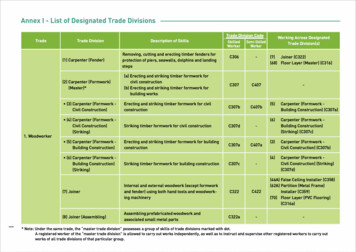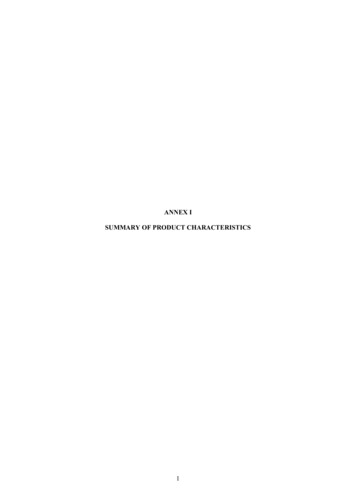
Transcription
ANNEX ISUMMARY OF PRODUCT CHARACTERISTICS1
1.NAME OF THE MEDICINAL PRODUCTBydureon 2 mg powder and solvent for prolonged-release suspension for injection2.QUALITATIVE AND QUANTITATIVE COMPOSITIONEach vial contains 2 mg of exenatide.For the full list of excipients, see section 6.1.3.PHARMACEUTICAL FORMPowder and solvent for prolonged-release suspension for injection.Powder: white to off-white powder.Solvent: clear, colourless to pale yellow to pale brown solution.4.CLINICAL PARTICULARS4.1Therapeutic indicationsBydureon is indicated in adults 18 years and older with type 2 diabetes mellitus to improve glycaemiccontrol in combination with other glucose-lowering medicinal products including basal insulin, whenthe therapy in use, together with diet and exercise, does not provide adequate glycaemic control.For study results with respect to combinations, effects on glycaemic control and cardiovascular events,and the populations studied, see sections 4.4, 4.5, and 5.1.4.2Posology and method of administrationPosologyThe recommended dose is 2 mg exenatide once weekly.Patients switching from immediate-release (Byetta) to prolonged-release (Bydureon or BydureonBCise) exenatide, may experience transient elevations in blood glucose concentrations, whichgenerally improve within the first two weeks after initiation of therapy. Patients switching between theprolonged-release exenatide products (Bydureon or Bydureon BCise) may do so, with no expectedrelevant effect on blood glucose concentrations.When prolonged-release exenatide is added to existing metformin and/or thiazolidinedione therapy,the current dose of metformin and/or thiazolidinedione can be continued. When added tosulphonylurea therapy, a reduction in the dose of sulphonylurea should be considered to reduce therisk of hypoglycaemia (see section 4.4).Prolonged-release exenatide should be administered once a week on the same day each week. The dayof weekly administration can be changed if necessary as long as the last dose was administered at leastthree days before. Prolonged-release exenatide can be administered at any time of day, with or withoutmeals.If a dose is missed, it should be administered as soon as practical, provided the next regularlyscheduled dose is due in 3 days or more. Thereafter, patients can resume their usual once weeklydosing schedule.2
If a dose is missed and the next regularly scheduled dose is due 1 or 2 days later, the patient should notadminister the missed dose, but instead resume prolonged-release exenatide on the next regularlyscheduled dosing day.The use of prolonged-release exenatide does not require additional self-monitoring. Blood glucoseself-monitoring is necessary to adjust the dose of sulphonylurea and of insulin, particularly whenprolonged-release exenatide therapy is started and insulin is reduced. A stepwise approach to insulindose reduction is recommended.If a different glucose-lowering treatment is started after the discontinuation of prolonged-releaseexenatide, consideration should be given to the prolonged release of the medicinal product (see section5.2).Special populationsElderlyNo dose adjustment is required based on age. However, as renal function generally declines with age,consideration should be given to the patient’s renal function (see Renal impairment) (see section 5.2).Renal impairmentNo dose adjustment is necessary for patients with mild or moderate renal impairment.Prolonged-release exenatide is not recommended for use in patients with end-stage renal disease orsevere renal impairment (glomerular filtration rate [GFR] 30 mL/min) (see section 4.4).Hepatic impairmentNo dose adjustment is necessary for patients with hepatic impairment (see section 5.2).Paediatric populationThe safety and efficacy of prolonged-release exenatide in children and adolescents aged under18 years have not yet been established. Currently available data are described in section 5.2 but norecommendation on a posology can be made.Method of administrationSubcutaneous useProlonged-release exenatide is for self-administration by the patient. Each kit should be used by oneperson only and is for single use.Prior to initiation of prolonged-release exenatide, it is strongly recommended that patients andcaregivers be trained by their healthcare professional. The “Instructions for the User”, provided in thecarton, must be followed carefully.Each dose should be administered in the abdomen, thigh, or the back of the upper arm as asubcutaneous injection immediately after suspension of the powder in the solvent.When used with insulin, prolonged-release exenatide and insulin must be administered as two separateinjections.For instructions on the suspension of the medicinal product before administration, see section 6.6 andthe “Instructions for the User”.4.3ContraindicationsHypersensitivity to the active substance or to any of the excipients listed in section 6.1.3
4.4Special warnings and precautions for useProlonged-release exenatide should not be used in patients with type 1 diabetes mellitus or for thetreatment of diabetic ketoacidosis.Prolonged-release exenatide is not a substitute for insulin. Diabetic ketoacidosis has been reported ininsulin-dependent patients after rapid discontinuation or dose reduction of insulin (see section 4.2).Prolonged-release exenatide must not be administered by intravenous or intramuscular injection.Renal impairmentIn patients with end-stage renal disease receiving dialysis, single doses of immediate-release exenatideincreased frequency and severity of gastrointestinal adverse reactions; therefore, prolonged-releaseexenatide is not recommended for use in patients with end-stage renal disease or severe renalimpairment (GFR 30 mL/min).There have been uncommon events of altered renal function with exenatide, including increased serumcreatinine, renal impairment, worsened chronic renal failure and acute renal failure, sometimesrequiring haemodialysis. Some of these events occurred in patients experiencing events that may affecthydration, including nausea, vomiting, and/or diarrhoea and/or receiving medicinal products known toaffect renal function/hydration status. Concomitant medicinal products included angiotensinconverting enzymes inhibitors, angiotensin-II antagonists, non-steroidal anti-inflammatory medicinalproducts and diuretics. Reversibility of altered renal function has been observed with supportivetreatment and discontinuation of potentially causative medicinal products, including exenatide.Severe gastrointestinal diseaseProlonged-release exenatide has not been studied in patients with severe gastrointestinal disease,including gastroparesis. Its use is commonly associated with gastrointestinal adverse reactions,including nausea, vomiting, and diarrhoea. Therefore, the use of prolonged-release exenatide is notrecommended in patients with severe gastrointestinal disease.Acute pancreatitisUse of GLP-1 receptor agonists has been associated with a risk of developing acute pancreatitis. Inclinical studies of prolonged-release exenatide, acute pancreatitis occurred in 0.3% of patients. Therehave been spontaneously reported events of acute pancreatitis with prolonged-release exenatide.Resolution of pancreatitis has been observed with supportive treatment, but very rare cases ofnecrotising or haemorrhagic pancreatitis and/or death have been reported. Patients should be informedof the characteristic symptom of acute pancreatitis: persistent, severe abdominal pain. If pancreatitis issuspected, prolonged-release exenatide should be discontinued; if acute pancreatitis is confirmed,prolonged-release exenatide should not be restarted. Caution should be exercised in patients with ahistory of pancreatitis.Concomitant medicinal productsThe concurrent use of prolonged-release exenatide with D-phenylalanine derivatives (meglitinides),alpha-glucosidase inhibitors, dipeptidyl peptidase-4 inhibitors or other GLP-1 receptor agonists hasnot been studied. The concurrent use of prolonged-release and immediate-release exenatide has notbeen studied and is not recommended.Interaction with warfarinThere have been spontaneously reported cases of increased INR (International Normalised Ratio),sometimes associated with bleeding, with concomitant use of warfarin and exenatide (see section 4.5).HypoglycaemiaThe risk of hypoglycaemia was increased when prolonged-release exenatide was used in combinationwith a sulphonylurea in clinical studies. Furthermore, in the clinical studies, patients on asulphonylurea combination, with mild renal impairment had an increased incidence of hypoglycaemiacompared to patients with normal renal function. To reduce the risk of hypoglycaemia associated withthe use of a sulphonylurea, reduction in the dose of sulphonylurea should be considered.4
Rapid weight lossRapid weight loss at a rate of 1.5 kg per week has been reported in patients treated with exenatide.Weight loss of this rate may have harmful consequences. Patients with rapid weight loss should bemonitored for signs and symptoms of cholelithiasis.Discontinuation of treatmentAfter discontinuation, the effect of prolonged-release exenatide may continue as plasma levels ofexenatide decline over 10 weeks. Choice of other medicinal products and dose selection should beconsidered accordingly, as adverse reactions may continue and efficacy may, at least partly, persistuntil exenatide levels decline.ExcipientsSodium content: This medicinal product contains less than 1 mmol sodium (23 mg) per dose, i.e.essentially “sodium-free”.4.5Interaction with other medicinal products and other forms of interactionSulphonylureasThe dose of a sulphonylurea may require adjustment due to the increased risk of hypoglycaemiaassociated with sulphonylurea therapy (see sections 4.2 and 4.4).Gastric emptyingThe results of a study using paracetamol as a marker of gastric emptying suggest that the effect ofprolonged-release exenatide to slow gastric emptying is minor and not expected to cause clinicallysignificant reductions in the rate and extent of absorption of concomitantly administered oralmedicinal products. Therefore, no dose adjustments for medicinal products sensitive to delayed gastricemptying are required.When 1,000 mg paracetamol tablets were administered, either with or without a meal, following14 weeks of prolonged-release exenatide therapy, no significant changes in paracetamol AUC wereobserved compared to the control period. Paracetamol Cmax decreased by 16% (fasting) and 5% (fed)and tmax was increased from approximately 1 hour in the control period to 1.4 hours (fasting) and1.3 hours (fed).The following interaction studies have been conducted using 10 mcg immediate-release exenatide butnot prolonged-release exenatide:WarfarinA delay in tmax of about 2 h was observed when warfarin was administered 35 min afterimmediate-release exenatide. No clinically relevant effects on Cmax or AUC were observed. IncreasedINR has been spontaneously reported during concomitant use of warfarin and prolonged-releaseexenatide. INR should be monitored during initiation of prolonged-release exenatide therapy inpatients on warfarin and/or cumarol derivatives (see sections 4.4 and 4.8).Hydroxy methyl glutaryl coenzyme A reductase inhibitorsLovastatin AUC and Cmax were decreased approximately 40% and 28%, respectively, and tmax wasdelayed about 4 h when immediate-release exenatide was administered concomitantly with a singledose of lovastatin (40 mg) compared with lovastatin administered alone. In 30-weekplacebo-controlled clinical studies with immediate-release exenatide, concomitant use of exenatideand HMG CoA reductase inhibitors was not associated with consistent changes in lipid profiles (seesection 5.1). No predetermined dose adjustment is required; however, lipid profiles should bemonitored as appropriate.Digoxin and lisinoprilIn interaction studies of the effect of immediate-release exenatide on digoxin and lisinopril there wereno clinical relevant effects on Cmax or AUC, however, a delay in tmax of about 2 h was observed.5
Ethinyl estradiol and levonorgestrelAdministration of a combination oral contraceptive (30 mcg ethinyl estradiol plus 150 mcglevonorgestrel) one hour before immediate-release exenatide did not alter the AUC, Cmax or Cmin ofeither ethinyl estradiol or levonorgestrel. Administration of the oral contraceptive 35 minutes afterexenatide did not affect AUC but resulted in a reduction of the Cmax of ethinyl estradiol by 45%, andCmax of levonorgestrel by 27-41%, and a delay in tmax by 2-4 h due to delayed gastric emptying. Thereduction in Cmax is of limited clinical relevance and no adjustment of dosing of oral contraceptives isrequired.Paediatric populationInteraction studies with exenatide have only been performed in adults.4.6Fertility, pregnancy and lactationWomen of childbearing potentialDue to the long washout period of prolonged-release exenatide, women of childbearing potentialshould use contraception during treatment with prolonged-release exenatide. This medicinal productshould be discontinued at least 3 months before a planned pregnancy.PregnancyThere are no adequate data from the use of prolonged-release exenatide in pregnant women. Studies inanimals have shown reproductive toxicity (see section 5.3). The potential risk for humans is unknown.Prolonged-release exenatide should not be used during pregnancy and the use of insulin isrecommended.Breast-feedingIt is unknown whether exenatide is excreted in human milk. Prolonged-release exenatide should not beused during breast-feeding.FertilityNo fertility studies in humans have been conducted.4.7Effects on ability to drive and use machinesProlonged-release exenatide has minor influence on the ability to drive and use machines. Whenprolonged-release exenatide is used in combination with a sulphonylurea, patients should be advised totake precautions to avoid hypoglycaemia while driving and using machines.4.8Undesirable effectsSummary of the safety profileThe most frequent adverse reactions were mainly gastrointestinal related (nausea which was the mostfrequent reaction and associated with the initiation of treatment and decreased over time, anddiarrhoea). In addition, injection site reactions (pruritus, nodules, erythema), hypoglycaemia (with asulphonylurea), and headache occurred. Most adverse reactions associated with prolonged-releaseexenatide were mild to moderate in intensity.Tabulated list of adverse reactionsThe frequency of adverse reactions of prolonged-release exenatide identified from clinical studies andspontaneous reports (not observed in clinical studies, frequency not known) are summarised in Table 1below.In the prolonged-release exenatide clinical studies, background therapies included diet and exercise,metformin, a sulphonylurea, a thiazolidinedione, a combination of oral glucose-lowering medicinalproducts or a basal insulin.6
The reactions are listed below as MedDRA preferred term by system organ class and absolutefrequency. Frequencies are defined as: very common ( 1/10), common ( 1/100 to 1/10),uncommon ( 1/1,000 to 1/100), rare ( 1/10,000 to 1/1,000) very rare ( 1/10,000) and notknown (cannot be estimated from the available data).Table 1: Adverse reactions of prolonged-release exenatide identified from clinical studies andspontaneous reportsSystem organ class/adverse reactiontermsFrequency of occurrenceVeryCommoncommonBlood and lymphatic system disordersDrug-inducedthrombocytopeniaImmune system disordersAnaphylactic reactionMetabolism and nutrition disordersHypoglycaemia (withX1a sulphonylurea)Hypoglycaemia (withX2,3insulin)Decreased appetiteX1DehydrationNervous system astrointestinal disordersIntestinal obstructionAcute pancreatitis (seesection nal painX1GastroesophagealX1reflux diseaseAbdominal layed gastricemptyingSkin and subcutaneous tissue disordersMacular and papularrashPruritus, and/ orX1urticariaAngioneurotic oedema7UncommonRareVery rareNotknownX4X1X1X1X1X1X1X1X5X4X4
System organ class/adverse reactiontermsFrequency of occurrenceVerycommonCommonUncommonRareVery rareNotknownX4Injection site abscessesand cellulitisHyperhidrosisX1AlopeciaX1Renal and urinary disordersAltered renal function,X1including acute renalfailure, worsenedchronic renal failure,renal impairment,increased serumcreatinine (see section4.4).General disorders and administration site conditionsInjection site pruritusX1FatigueX1Injection site erythemaX1Injection site rashX1AstheniaX1Feeling jitteryX1InvestigationsInternationalX4normalised ratioincreased (see section4.4)1Rate based on twelve prolonged-release exenatide completed long-term efficacy and safety studiesn 2868 total (patients on sulphonylurea n 1002).2Based on hypoglycaemic events that 1. Result in loss of consciousness, seizure, or coma whichresolves after administration of glucagon or glucose OR 2. Require third-party assistance to resolvebecause of impairment in consciousness or behaviour and has glucose value of 54 mg/dL(3 mmol/L) OR 3. Result in symptoms consistent with hypoglycaemia with a concomitant glucose 54 mg/dL (3 mmol/L) prior to treatment.3Frequency reported from the 28-week controlled treatment period of the prolonged-release exenatideas add-on to insulin glargine study (N 231).4Rate based on prolonged-release exenatide spontaneous reports data (unknown denominator).5Rate based on sixteen prolonged-release exenatide completed long term efficacy and safety studiesn 4086 total.Description of selected adverse reactionsDrug-induced thrombocytopeniaDrug-induced thrombocytopenia (DITP) with exenatide-dependent anti-platelet antibodies has beenreported in the postmarketing setting. DITP is an immune-mediated reaction that is caused by drugdependent platelet-reactive antibodies. These antibodies cause destruction of platelets in the presenceof the sensitizing drug.HypoglycaemiaThe incidence of hypoglycaemia was increased when prolonged-release exenatide was used incombination with a sulphonylurea (24.0% versus 5.4%) (see section 4.4). To reduce the risk ofhypoglycaemia associated with the use of a sulphonylurea, reduction in the dose of sulphonylurea maybe considered (see sections 4.2 and 4.4).8
Prolonged-release exenatide was associated with a significantly lower incidence of episodes ofhypoglycaemia than basal insulin in patients also receiving metformin therapy (3% versus 19%) and inpatients also receiving metformin plus sulphonylurea therapy (20% versus 42%).Across 12 studies of prolonged-release exenatide most episodes (99.9% n 649) of hypoglycaemiawere minor, and resolved with oral administration of carbohydrate. One patient was reported withmajor hypoglycaemia since he had a low blood glucose value (2.2 mmol/L) and requested assistancewith oral carbohydrate treatment which resolved the event.When prolonged-release exenatide was added to basal insulin, no initial dose adjustment of insulinwas required. Prolonged-release exenatide in combination with basal insulin showed no clinicallysignificant differences in the incidence of hypoglycaemic episodes compared to insulin. There were noepisodes of major hypoglycaemia in the prolonged-release exenatide with insulin group.NauseaThe most frequently reported adverse reaction was nausea. In patients treated with prolonged-releaseexenatide, generally 20% reported at least one episode of nausea compared to 34% ofimmediate-release exenatide patients. Most episodes of nausea were mild to moderate. With continuedtherapy, the frequency decreased in most patients who initially experienced nausea.The incidence of withdrawal due to adverse events during the 30-week controlled study was 6% forprolonged-release exenatide treated patients, 5% for immediate-release exenatide treated patients. Themost common adverse events lead
Bydureon 2mg powder and solvent for prolonged-release suspension for injection 2. QUALITATIVE AND QUANTITATIVE COMPOSITION Each vial contains 2mg ofexenatide. For the full list of excipients, see section 6.1. 3. PHARMACEUTICAL FORM Powder and solvent for prolonged-release sus
